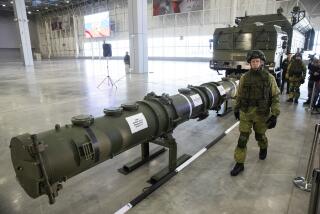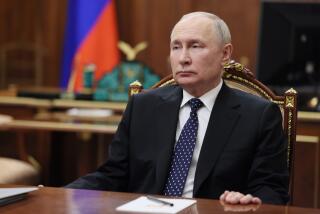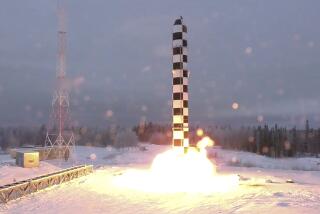Moscow Drops Arms Pact Link to âStar Warsâ
MOSCOW â As both sides offered new ideas to speed arms control talks, the Soviet Union appeared Thursday to remove one of the last major obstacles to a U.S.-Soviet strategic nuclear arms reduction treaty by eliminating linkage between the treaty and the U.S. âStar Warsâ program.
Soviet Foreign Minister Eduard A. Shevardnadze told visiting Secretary of State James A. Baker III that Moscow is willing to sign and implement a new Strategic Arms Reduction Talks (START) agreement to cut offensive weapons by about half without any declared linkage to how each side must conduct research work on defensive systems, according to a senior U.S. official.
For years, Moscow insisted that the START treaty could not be signed until the United States gave up its plan to develop a space-based anti-missile defense system, known as âStar Wars.â Then, the Soviets edged away from that position step-by-step; now they have provided what the U.S. official termed âthe important clarification on this longstanding question.â
However, Democrats in Congress may still insist on linking the offensive and defensive issues in their continuing effort to curtail the âStar Warsâ program, another U.S. official said. But this official noted that, with or without such linkage, Congress would always have the power to enforce its policy on the program through the budgetary process.
For its part in the joint attempt to complete new nuclear and conventional arms treaties by the end of the year, the U.S. side brought new proposals on how air-launched cruise missiles should be counted within the total of 6,000 nuclear weapons to which both nations would be limited under a new START agreement. Essentially, the new U.S. proposal offers a compromise on such issues as missile range and bomber carrying capabilities, U.S. officials said.
Soviet Deputy Foreign Minister Alexander A. Bessmertnykh said the new U.S. position on the cruise missiles âcould promote the solution to this problem.â
The U.S. negotiators also provided new ideas on how to monitor spare and stored missiles that are not deployed--and how to broadcast openly the in-flight data from a missile test so that the other side will be aware of the missileâs various characteristics.
âWe gave them an awful lot to chew on,â another senior U.S. official said. The initial Soviet reaction was positive, he added, and detailed replies are expected before Bakerâs visit ends Saturday.
Soviet spokesman Gennady I. Gerasimov also said that the Soviet side will continue to call for new arms talks to limit naval forces, as well as for limits on sea-launched cruise missiles. The United States is opposed to both.
Bakerâs team also presented President Bushâs new proposal to cut U.S. and Soviet troops on the ground in Central Europe to 195,000 for each side, as well as new ideas on how to count aircraft and tanks for any agreement to reduce conventional forces in Europe.
The same proposals were presented Thursday by North Atlantic Treaty Organization nations to the Warsaw Pact at the 23-nation conventional forces negotiations that are under way in Vienna.
Essentially, NATOâs new aircraft proposal lowered its previously proposed ceiling on ground attack aircraft from 5,700 to 4,700 for each alliance and would exclude âprimary trainersâ--jet training aircraft--while allowing an additional 500 air-to-air fighter interceptors above the ceiling, according to reports from Vienna.
A senior NATO official in Brussels was quoted by the Associated Press as saying that the NATO side also agreed to narrow the definition of combat helicopters to resolve a difference with the East.
The new NATO position on counting tanks seeks to distinguish between large, or âmainâ battle tanks, on the one hand, and light tanks and armored personnel carriers on the other, within the 20,000 tanks and 28,000 personnel carriers that both sides have agreed to set as ceilings in these categories.
The new troop ceiling being proposed was first announced Jan. 31 by President Bush. It represented an 80,000-soldier reduction in the previously proposed ceiling.
The Soviet Union has an estimated 565,000 troops stationed in Europe outside its borders, with well over 500,000 of them within the central zone. There are about 305,000 U.S. troops in Western Europe, with approximately 250,000 of those stationed in the area of application, according to Western estimates.
The Warsaw Pact offered no reaction Thursday to the formal NATO presentation. The senior NATO official told the Associated Press that the West expects a response at a meeting next week of the two alliances in Ottawa. The âOpen Skiesâ gathering there is officially being held to review a plan for unarmed reconnaissance flights over rival alliance territories, a proposal designed to reduce East-West tensions.
The Soviet sideâs apparent concession on anti-missile defenses Thursday was an advance on its position in September. Back then, according to U.S. officials, it was demanding that the START treaty include a provision specifically giving either signatory the right to withdraw from the treaty if, in its judgment, the 1972 Anti-Ballistic Missile (ABM) Treaty was being violated.
The demand was aimed at giving the Soviet Union leverage with which to curb âStar Wars.â It could contend that any project being conducted in the program is a violation of the ABM agreement and threaten to withdraw from the START treaty unless it were stopped.
The Soviets now say they would still prefer such a clause, âbut not as a precondition for signing and implementing the START agreement,â the senior U.S. official said.
Under the new Soviet position, each side will have the right to withdraw from the treaty if its âsupreme national interestsâ are jeopardized--a standard phrase in arms agreements--but the START treaty will not be directly tied to the ABM treaty.
More to Read
Sign up for Essential California
The most important California stories and recommendations in your inbox every morning.
You may occasionally receive promotional content from the Los Angeles Times.











